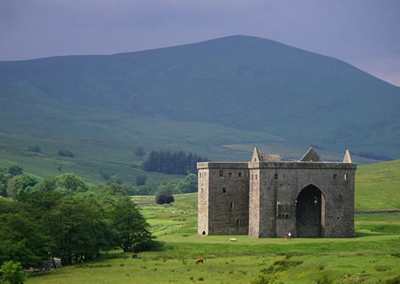Wind farm battle over Scottish castle
One of Scotland's most historic castles could be blighted by a proposed wind farm development in the Scottish Borders


One of Scotland's most romantic castles could be blighted by a huge wind-farm development. Last month, an application was submitted to Scottish Borders Council by Windy Edge Wind Farm Limited for 17 398ft-high wind turbines, which would stand beside Hermitage Castle in Roxburghshire. The 400-year-old Scheduled Monument, managed by Historic Scotland, has a dramatic past- author George Macdonald Fraser described it as ‘the guardhouse of the bloodiest valley in Britain', and Mary, Queen of Scots made a scandalous visit to her secret lover, the 4th Earl of Bothwell, there in 1566 after he was injured in battle.
To the south of the castle is the Langholm Estate, part of Buccleuch Estates, which is lodging an objection. ‘To pollute the landscape backdrop of the castle with all its power to evoke the history and heritage of the Scottish Borders would be nothing short of vandalism,' stresses The Duke of Buccleuch. His hydrocarbons and minerals director, Mark Oddy, agrees: ‘This is one of the most important buildings of its kind in Scotland, and our feeling is that this proposal will destroy its setting forever.

Hermitage Castle in the Scottish Borders (image: www.visitscotland.com)
The landscape has changed very little for centuries, but the wind-farm development is going to be visible from any vantage point.' Langholm Moor is also designated a Special Protection Area for hen harriers, whose flight path would be blocked by the turbines.
The Hermitage Action Group (www.hermitageaction-group.com) is also gearing up. ‘The developers get three years to prepare their case; we only get a matter of weeks,' says chairman Malcolm McGregor. ‘But we can't lie down and allow ourselves to be flattened.
The turbines will devastate the integrity of the landscape. We envisage this battle going on for years-it's going to be a marathon.' Last week, energy secretary Ed Davey announced that, from 2017, wind-farm subsidies will be cut by 25% to ‘protect consumer bills'.
Wind-farm opponents welcome the move, but, according to John Constable of the Renewable Energy Foundation, it's not that straightforward. ‘The rate per unit generated seems to have been increased, counteracting the 10% cut announced last year in the Renewable Obligation for onshore wind. However, the length of subsidy entitlement has been reduced from a guaranteed 20 years to 15.' Physical evidence suggests that wind farms wear out in as little as 10-15 years and need to be replaced, meaning that the total investment required to meet targets and, consequently, the cost per unit of wind-generated energy, is much higher than initially projected. ‘Developers are using the land as a way of harvesting subsidies,' Dr Constable warns.
Exquisite houses, the beauty of Nature, and how to get the most from your life, straight to your inbox.
Momentum is already building in the industry to lobby the Department for Energy and Climate Change for the previous contract length to be reinstated. ‘The wind industry is formidable, and the Government seems to have almost zero concern for the consumer,' adds Dr Constable. ‘It's much easier to cosy up to industrial interests.'
* Follow Country Life magazine on Twitter
Emma Hughes lives in London and has spent the past 15 years writing for publications including the Guardian, the Telegraph, the Evening Standard, Waitrose Food, British Vogue and Condé Nast Traveller. Currently Country Life's Acting Assistant Features Editor and its London Life restaurant columnist, if she isn't tapping away at a keyboard she's probably taking something out of the oven (or eating it).
-
 'The ugliness and craziness is a part of its charm': The Country Life guide to Bangkok
'The ugliness and craziness is a part of its charm': The Country Life guide to BangkokWhere to stay, where to eat and what to do in the Thai capital.
-
 There are a billion microbes in a teaspoon of soil. Leaving the leaves to Nature feeds and nourishes them
There are a billion microbes in a teaspoon of soil. Leaving the leaves to Nature feeds and nourishes themLeaf blowers aren't just futile and polluting — they're actively bad for the health of your garden, not to mention your mental wellbeing. Time to reach for the rake, says Isabel Bannerman.
